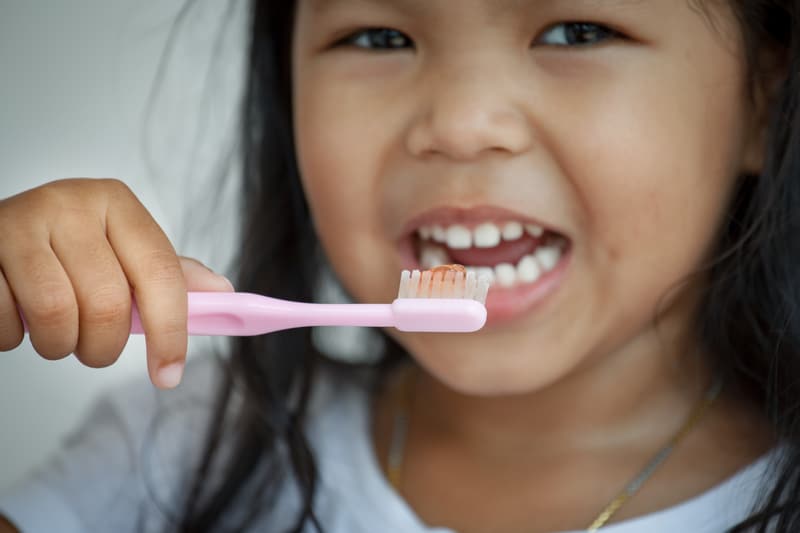 Kids & habits are funny. Kids can so easily remember that dessert comes after dinner, but they can’t they seem to remember that teeth-brushing does too. Or kids are be able to create a habit out of one random incident (i.e. “but we had ice cream after school yesterday, that’s what we do now”), yet reminding them 85,000 times to put dirty clothes into the hamper never seems to turn into a habit. But back on the teeth-brushing. We’ll leave the reminding up to you, but one thing we can help with is sharing some tips on choosing a toxic chemical free toothpaste. You might be surprised to know that common toothpaste ingredients are not as safe as you think, even in kids’ toothpaste brands. Here is what you need to know to avoid toxic chemicals in the toothpastes your family uses.
Kids & habits are funny. Kids can so easily remember that dessert comes after dinner, but they can’t they seem to remember that teeth-brushing does too. Or kids are be able to create a habit out of one random incident (i.e. “but we had ice cream after school yesterday, that’s what we do now”), yet reminding them 85,000 times to put dirty clothes into the hamper never seems to turn into a habit. But back on the teeth-brushing. We’ll leave the reminding up to you, but one thing we can help with is sharing some tips on choosing a toxic chemical free toothpaste. You might be surprised to know that common toothpaste ingredients are not as safe as you think, even in kids’ toothpaste brands. Here is what you need to know to avoid toxic chemicals in the toothpastes your family uses.
Choosing a Toxic Chemical Free Toothpaste: Top 6 Ingredients to Avoid
Artificial colors
If it has a bright fun color, skip it. The most common dyes are D&C Red 30, FD&C Blue 1 and D&C Yellow 10. These are synthetic dyes derived from petroleum and coal tar, and they can accumulate over time in the body to cause organ system toxicity. These colors don’t enhance the cleaning power of toothpaste anyway, so why take the risk?
Triclosan
You probably know to avoid this hormone-disrupting toxic villain but we’d be remiss if we’d didn’t include it here. It’s an anti-microbial agent that is used to fight plaque & gingivitis, and it’s associated with liver damage, cancer & endocrine disruption. You’ve probably read in the news that it’s been banned from several types of products, but unfortunately it is still alive & well in toothpastes.
PEGs & Propylene Glycol
PEG’s or polyethylene glycols are petroleum-based compounds used in toothpastes to help keep ingredients stable and enhance the penetration of other active ingredients. PEG’s are associated with the carcinogenic contaminant 1,4-dioxane. Exposure to PEG’s and trace amounts of 1,4-dioxane can lead to a number of health concerns including cancer, liver damage, and kidney damage. Propylene glycol is used to smooth out the texture in toothpastes, and it’s also used in antifreeze & paints. Not surprisingly, it’s linked with skin irritation and organ toxicity. Skip both of these groups of ingredients and choose a toxic chemical free toothpaste instead.
Parabens
Parabens are preservatives added to toothpastes to stop fungus and bacteria from growing in them. The CDC has detected parabens in almost all Americans tested. They are linked to a multitude of health risks including cancer, endocrine disruption, reproductive toxicity, neurotoxicity and skin irritation. To avoid parabens, look for and avoid ingredient names that contain the word “paraben” contain paraben, like methylparaben, propylparaben, ethylparaben, and butylparaben.
Diethaloneamine (DEA)
Diethanolamine helps to create foam in toothpastes as well as in household cleaning products. It’s been banned in the EU in products like toothpaste and is associated with hormone-disruption, cancer and organ toxicity.
Sodium Fluoride
Sodium fluoride is the hero anti-cavity ingredient in many toothpastes and it’s not without controversy. Those against it say it’s not needed if good dental hygiene practices (regular brushing and flossing, avoiding sugary foods & drinks) are followed and that it’s linked with irritation to the skin, eyes, or lungs, organ system toxicity & even neurotoxicity. They also say children are over-exposed to it given its presence in water, and also cite the risk that young brushers will swallow toothpaste. Those advocating for fluoride say that the dosages in toothpastes are low enough to be safe and that it really does help keep teeth strong. This is a good summary of the arguments. Given the debate, we recommend checking out some of the research yourself then weighing that against the dental hygiene practices of your family. If you have consistent brushers & flossers who don’t eat a lot of sugary foods (hats off to you!), then you might want to avoid it.
Learn More
Luckily, you can find a more toxic chemical free toothpaste by utilizing the EWG Skin Deep Database, which provides comprehensive information and a rating system to help you sort through what’s safe and what’s not. Toothpastes are a hard category to crack when it comes to avoiding toxic chemicals, so you’ll probably find yourself making some compromises. For example, some experts recommend avoiding toothpastes with artificial sweeteners. We believe that having a good Brusher outweighs the potential downside of artificial sweeteners, given the health risks around artificial sweeteners don’t seem to be as concrete as the risks associated with the other ingredients on this list.
We believe it helps to reduce your family’s exposure to toxic chemicals wherever you possibly can and that even eliminating a few nasty chemicals is well worth it. At Force of Nature, we are proud to offer a nontoxic cleaner that’s as effective as bleach. We’re dedicated to helping educate families on product safety and we help support other brands that are offer nontoxic solutions. You can learn more about us here and visit our blog to learn more about chemical safety.



